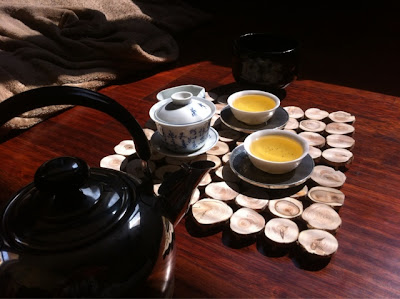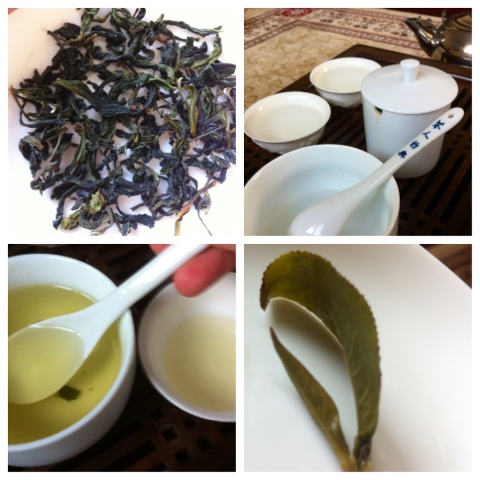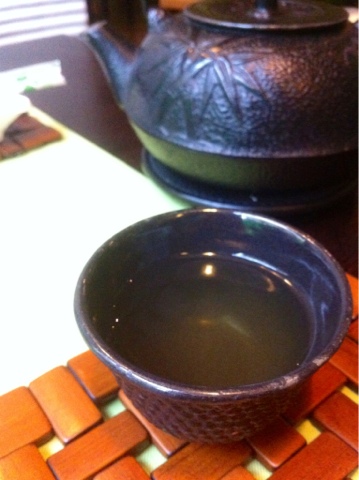As the days grow longer and warm rays enter my tea room, I am switching to greener oolongs. Refreshing! I am saving the last bits of my silver needles white tea for unexpectedly cold and rainy spring days. When those run out, Japanese green teas will make for perfect companions in summer months ahead.
Tuesday, April 23, 2013
Saturday, April 20, 2013
Inner balance 無極 wu2 ji2
So I've learnt, that each time I come to the tea table, I leave all extreme 極 emotions of ecstasy or disappointment behind and brew with a calm and composed mind. I've found this partial switching off of the mind to have helped reduce the shakiness in my hands. It is largely psychosomatic and is one reason why I started attending lessons in calligraphy some 2 years ago. This practice of writing demands that you hold the brush with your hand and not rest your arms on the tabletop. The stabilising force comes from yourself without reliance on any other hard surfaces.
One time after sipping tea that I prepared, teaparker advised me that perhaps I should invest more love, time and attention into the tea that I brew. On hindsight, he was spot on as I more and more am able to see the influence that my state of mind has on the quality of infusions as well as the look and feel of my brush strokes!
One time after sipping tea that I prepared, teaparker advised me that perhaps I should invest more love, time and attention into the tea that I brew. On hindsight, he was spot on as I more and more am able to see the influence that my state of mind has on the quality of infusions as well as the look and feel of my brush strokes!
Thursday, April 18, 2013
Always room for improvment
Left with the last few grams of Jinxuan oolong tea from last spring, I brewed this tea yesterday but thought that the tea tasted hollow and flat from what I last remembered of it. Perhaps the fluctuating humidity levels or negligence in storage did no favours to help keep it in tip top condition, but I decided to give this tea a second try today, paying more attention to the way I brewed it and letting it rest in my antique seed jar as water came to a gradual boil on the stove.
This is the resulting infusion from today's brewing which I thought to be less dull in appearance. The difference in colour intensity also translates into a more flavoursome cup of tea and naturally a greater sense of satisfaction and enjoyment. It would have been most upsetting had I deemed this tea to be spoilt and thrashed. Wastage doesn't run in my blood ;-), but I certainly have no hesitation in chucking out tea samples by the kilograms when they ruin my system (look out for mouthfeel, aftertaste and overall sensation in your body and extremities. Most importantly, be honest with yourself regardless of how much you have paid for the tea, or its associated branding)
So the next time you think your tea doesn't taste quite right, don't be quick in passing "the death sentence". Rather, examine your tea once again, give it a good sniff and some well-deserved attention when brewing. Mindlessly dousing tea leaves with hot water in between infusions is commonplace. If you expect teas brewed in this manner to be at their best, think again.
Wednesday, April 17, 2013
Making your own tests
Admittedly, I am not as diligent as I should be in trying out new teas. Perhaps a part of me is rather satisfied with the collection that I already have. When the weather finally turned for the better last week, I found a renewed level of strength and enthusiasm to revive the scientist in me!
Some noteworthy moments include discovering rather subtle notes in deep roasted teas, noticing very obvious similarities between different tea cultivars as a result of similar processing methods, identifying for myself exactly the kinds of teas I gravitate towards apart from the green unroasted high mountain oolongs, sharing my cup of tea with the neighbour and observing what most people like as opposed to what some people appreciate, etc.
Such tests are made on a levelled field with the use of porcelain or the fancier and more precise silver teaware because clay teaware has the ability to further refine teas. With a few grams of these handsome looking baozhong tea leaves in my preheated cup, I infused the tea in boiled water for 5 minutes because more time allows for a larger release of all things good and bad from the tea (if they exist).
Besides distributing tea amongst cups, the porcelain spoon acts like a magnifying glass. Think of it as a magnified nose, where smells are amplified when the convex side of the spoon is presented close to our nostrils.
Examining the colour of the infusion (right colour for the tyoe of tea you drink, varying intensities of yellowish green in the case of baozhong oolongs), drinking it (clean aftertaste, no churning sensation in the stomach being a good quality indicator) and finally taking a good look (tippy in dried form, buds aplenty) and feel (tenderness) of the spent tea leaves are all part of due diligence that a discerning consumer would undertake!
Some noteworthy moments include discovering rather subtle notes in deep roasted teas, noticing very obvious similarities between different tea cultivars as a result of similar processing methods, identifying for myself exactly the kinds of teas I gravitate towards apart from the green unroasted high mountain oolongs, sharing my cup of tea with the neighbour and observing what most people like as opposed to what some people appreciate, etc.
Such tests are made on a levelled field with the use of porcelain or the fancier and more precise silver teaware because clay teaware has the ability to further refine teas. With a few grams of these handsome looking baozhong tea leaves in my preheated cup, I infused the tea in boiled water for 5 minutes because more time allows for a larger release of all things good and bad from the tea (if they exist).
Besides distributing tea amongst cups, the porcelain spoon acts like a magnifying glass. Think of it as a magnified nose, where smells are amplified when the convex side of the spoon is presented close to our nostrils.
Examining the colour of the infusion (right colour for the tyoe of tea you drink, varying intensities of yellowish green in the case of baozhong oolongs), drinking it (clean aftertaste, no churning sensation in the stomach being a good quality indicator) and finally taking a good look (tippy in dried form, buds aplenty) and feel (tenderness) of the spent tea leaves are all part of due diligence that a discerning consumer would undertake!
Wednesday, April 10, 2013
Some like it spicy
My deeply entrenched roots in peranakan cuisine have finally taken a toll on my system all of yesterday and some time today.
I haven't had hot chilli pepper for a while now. This is something that I have consciously avoided as spicy foods tend to desensitise our sense of taste and smell, but old habits take time to break.
Hard lesson learnt and I am turning to some fermented organic oolong for comfort.
I haven't had hot chilli pepper for a while now. This is something that I have consciously avoided as spicy foods tend to desensitise our sense of taste and smell, but old habits take time to break.
Hard lesson learnt and I am turning to some fermented organic oolong for comfort.
Wednesday, April 3, 2013
Tips for brewing regular grade green teas
Once the tea leaves are sufficiently moistened (you should be able to see the leaves gradually opening up or pick up the brisk scent of green tea), proceed to fill up your gaiwan with hot water from the kettle. Replace the lid.
The slow and steady movements when preparing gongfu tea allow enough time in between steps for water to cool down. Keeping a thermometer and stopwatch at hand may seem more straightforward but don't seem very in line with the spirit of relaxation for me. By using my senses, I am in fact sharpening my gongfu cha skills and moving away from a reliance on an equipment-overload tea session.
Something that I noticed about Japanese green teas is the lesser emphasis on the luminosity and transparency of the infusion. You cannot avoid those spinachy green bits in your tea cups however narrow the gap is between the lid and gaiwan.
Paying for tea
Tea this afternoon was genmaicha, a rice green tea from Japan. I tasted diluted light green tea with a hint of strawberry scent. There is no aftertaste, the tea felt asphyxiated. I lifted the hot lid to find no visible traces of roasted rice, not to mention whole tea leaves. The content was murky green and I did not feel like it anymore. It was a pity because everything looked so right on the outside. How many occasions are we in fact paying for delicious wholesome tea as opposed to the right setting, great atmosphere and maybe some elegant looking pieces of teaware? I would be a happier paying customer if every element were put into its rightful place.
Subscribe to:
Posts (Atom)




